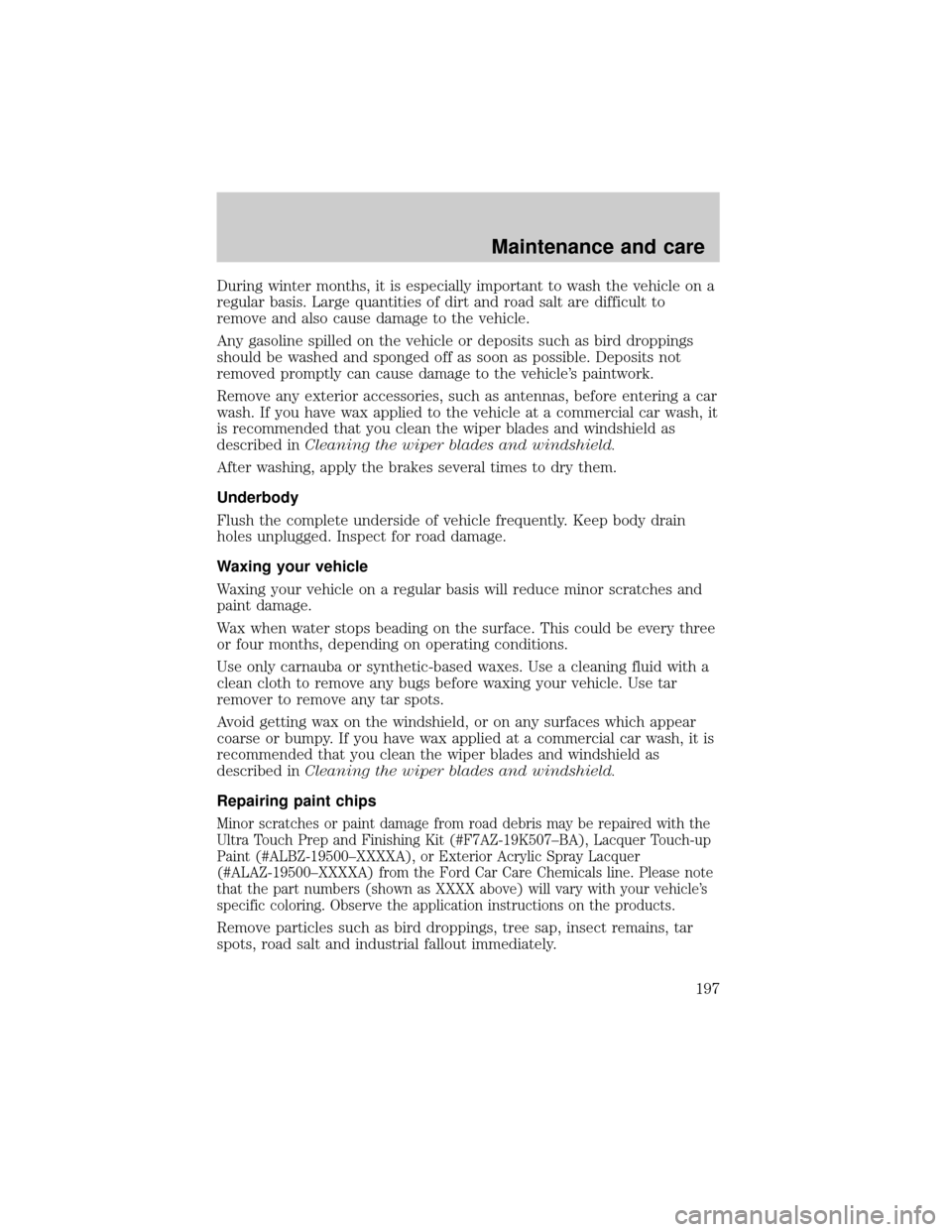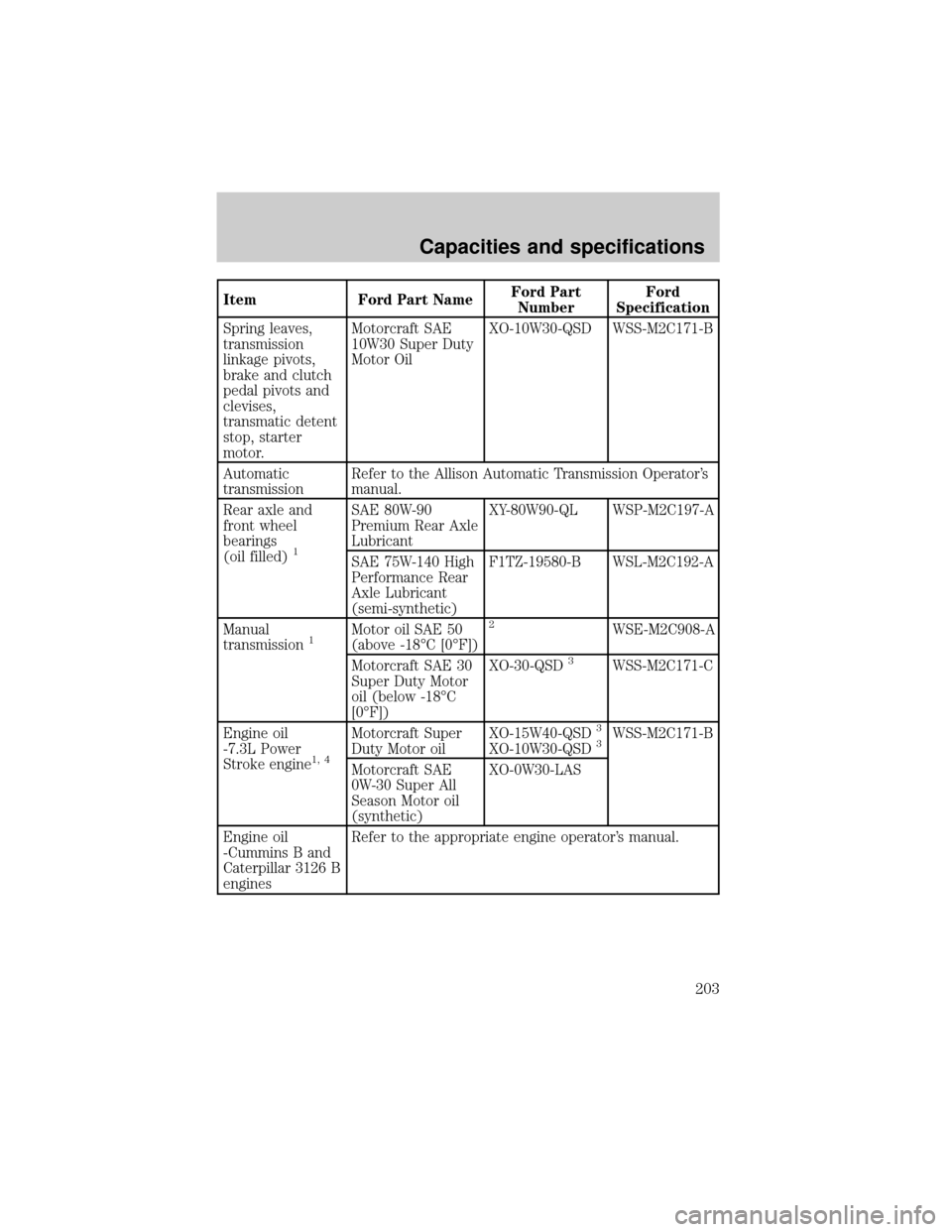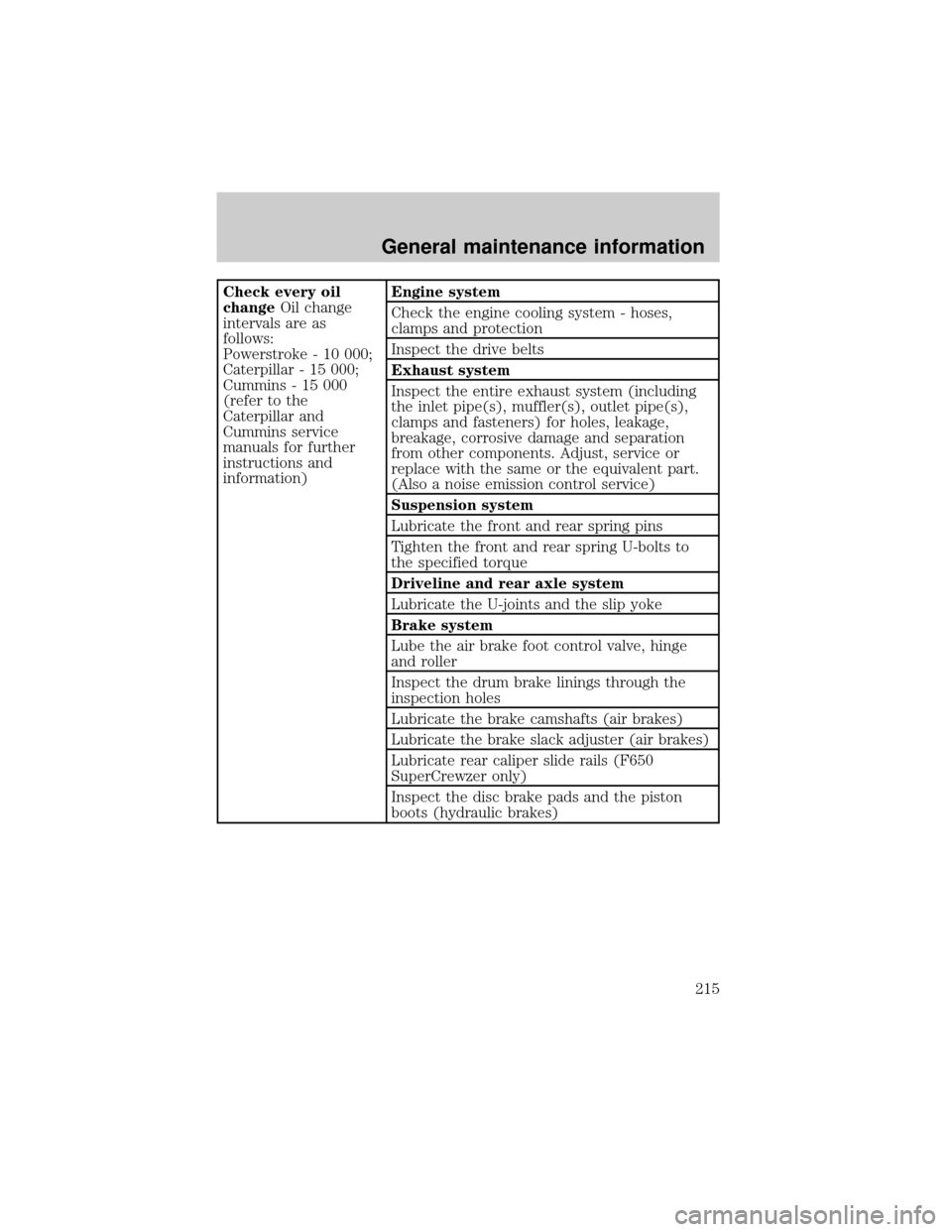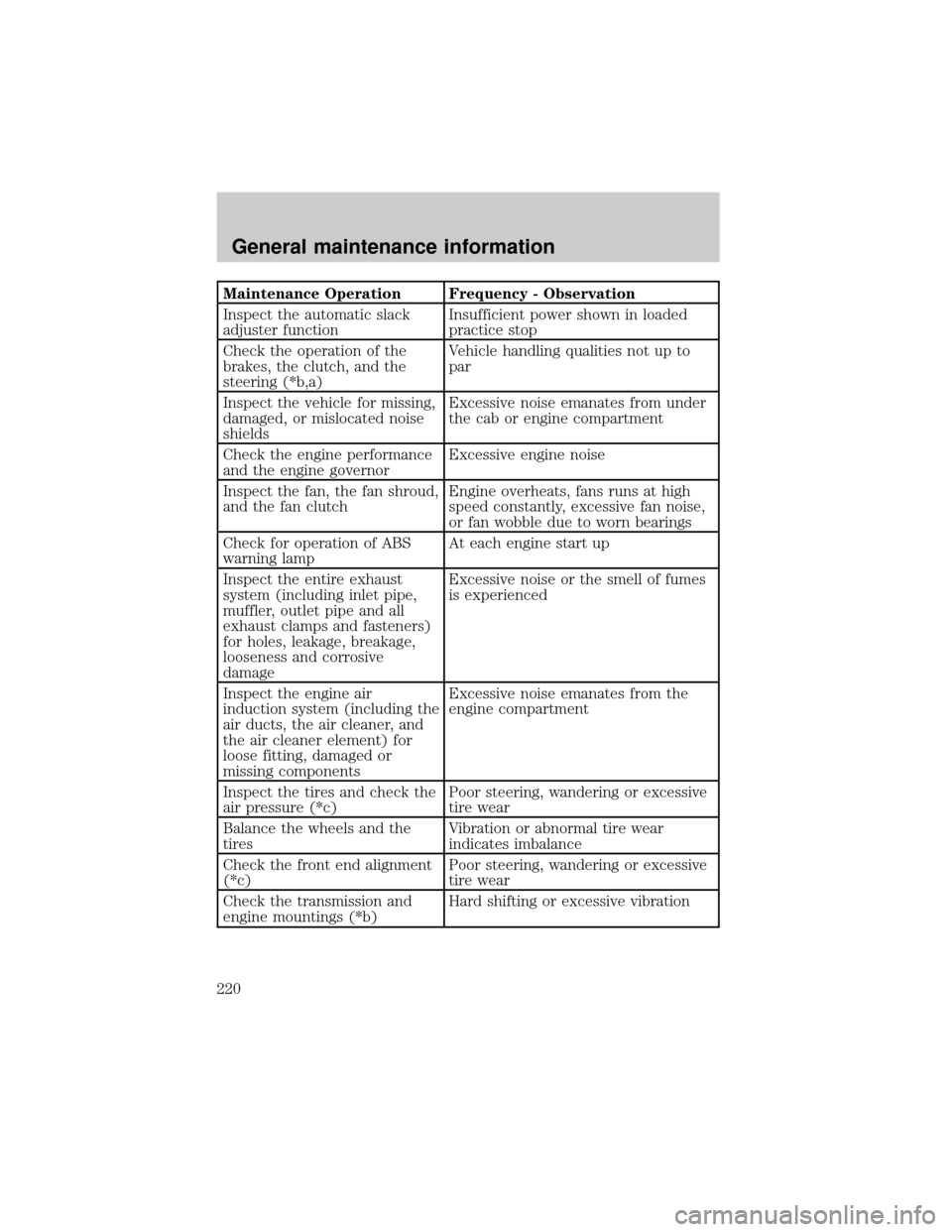Page 197 of 240

During winter months, it is especially important to wash the vehicle on a
regular basis. Large quantities of dirt and road salt are difficult to
remove and also cause damage to the vehicle.
Any gasoline spilled on the vehicle or deposits such as bird droppings
should be washed and sponged off as soon as possible. Deposits not
removed promptly can cause damage to the vehicle's paintwork.
Remove any exterior accessories, such as antennas, before entering a car
wash. If you have wax applied to the vehicle at a commercial car wash, it
is recommended that you clean the wiper blades and windshield as
described inCleaning the wiper blades and windshield.
After washing, apply the brakes several times to dry them.
Underbody
Flush the complete underside of vehicle frequently. Keep body drain
holes unplugged. Inspect for road damage.
Waxing your vehicle
Waxing your vehicle on a regular basis will reduce minor scratches and
paint damage.
Wax when water stops beading on the surface. This could be every three
or four months, depending on operating conditions.
Use only carnauba or synthetic-based waxes. Use a cleaning fluid with a
clean cloth to remove any bugs before waxing your vehicle. Use tar
remover to remove any tar spots.
Avoid getting wax on the windshield, or on any surfaces which appear
coarse or bumpy. If you have wax applied at a commercial car wash, it is
recommended that you clean the wiper blades and windshield as
described inCleaning the wiper blades and windshield.
Repairing paint chips
Minor scratches or paint damage from road debris may be repaired with the
Ultra Touch Prep and Finishing Kit (#F7AZ-19K507±BA), Lacquer Touch-up
Paint (#ALBZ-19500±XXXXA), or Exterior Acrylic Spray Lacquer
(#ALAZ-19500±XXXXA) from the Ford Car Care Chemicals line. Please note
that the part numbers (shown as XXXX above) will vary with your vehicle's
specific coloring. Observe the application instructions on the products.
Remove particles such as bird droppings, tree sap, insect remains, tar
spots, road salt and industrial fallout immediately.
Maintenance and care
197
Page 201 of 240
REAR AXLE REFILL CAPACITIES
Make and model Approximate capacity
Rockwell RS-17-144116.6L (35 pints)
Rockwell RS-17-1451, 216.6L (35 pints)
Rockwell RS-21-1451, 216.6L (35 pints)
Rockwell RS-23-1601, 218.9L (40 pints)
1Quantities listed are approximate. Fill axle until the lubricant level is at
bottom of filler hole, with vehicle on level ground.
2If hubs have been removed, add an additional 0.75 liter (1.6 pints) of
axle lubricant. Add lubricant through the axle vent.
FUEL TANK CAPACITIES
Type Approximate capacity
Single tank 246.09L (65 gallons)
Dual tank 492.18L (130 gallons)
LUBRICANT SPECIFICATIONS
Item Ford Part NameFord Part
NumberFord
Specification
Brake and clutch
fluid
(if equipped)High Performance
DOT 3 Motor
Vehicle Brake FluidC6AZ-19542-AB ESA-M6C25-A
and DOT 3
Body hinges,
hood hinges and
latches.Multi-Purpose
GreaseD0AZ-19584-AA
or
F5AZ-19G209-AAESB-M1C93-B
or
ESR-M1C159-A
Lock cylinders Penetrating
LubricantXL-1 N/A
Capacities and specifications
201
Page 202 of 240
Item Ford Part NameFord Part
NumberFord
Specification
Front axle spindle
pins, steering
linkage, front and
rear spring
shackle pins,
steering column
U-joints, steering
shaft slip yoke
and universal
joint, steering
shaft pillow block
bearing, clutch
linkage fittings.Premium Long Life
GreaseXG-1-C or
XG-1-KESA-M1C75-B
Bushings, front
wheel bearings
(grease packed
type)and seals,
fuel shut-off
solenoid linkage,
air brake control
valve, linkage,
treadle hinge and
roller,
transmission and
transmission
cables, clutch
release bearing
hub, transmission
shift lever pivot.Premium Long Life
GreaseXG-1-C or
XG-1-KESA-M1C75-B
Door
weatherstripsSilicone Lubricant F7AZ-19G208-BA
and
F5AZ-19553-AAESR-M13P4-A
DriveshaftU-joints
and slip splines,
power steering
gear output shaft.High Temperature
4 x 4 Front Axle
and Wheel Bearing
GreaseE8TZ-19590-A ESA-M1C198-A
Capacities and specifications
202
Page 203 of 240

Item Ford Part NameFord Part
NumberFord
Specification
Spring leaves,
transmission
linkage pivots,
brake and clutch
pedal pivots and
clevises,
transmatic detent
stop, starter
motor.Motorcraft SAE
10W30 Super Duty
Motor OilXO-10W30-QSD WSS-M2C171-B
Automatic
transmissionRefer to the Allison Automatic Transmission Operator's
manual.
Rear axle and
front wheel
bearings
(oil filled)
1
SAE 80W-90
Premium Rear Axle
LubricantXY-80W90-QL WSP-M2C197-A
SAE 75W-140 High
Performance Rear
Axle Lubricant
(semi-synthetic)F1TZ-19580-B WSL-M2C192-A
Manual
transmission
1Motor oil SAE 50
(above -18ÉC [0ÉF])2WSE-M2C908-A
Motorcraft SAE 30
Super Duty Motor
oil (below -18ÉC
[0ÉF])XO-30-QSD
3WSS-M2C171-C
Engine oil
-7.3L Power
Stroke engine
1, 4
Motorcraft Super
Duty Motor oilXO-15W40-QSD3
XO-10W30-QSD3WSS-M2C171-B
Motorcraft SAE
0W-30 Super All
Season Motor oil
(synthetic)XO-0W30-LAS
Engine oil
-Cummins B and
Caterpillar 3126 B
enginesRefer to the appropriate engine operator's manual.
Capacities and specifications
203
Page 212 of 240
AIR BRAKE ADJUSTMENT
Failure to maintain proper air brake adjustment can result in
reduction or loss of braking ability.
Air brake inspection and adjustment should be performed by a qualified
service technician in accordance with the instructions in the Ford Truck
Service Manual.
Cam brakes - automatic slack adjusters
Inspect standard air brakes equipped with automatic slack adjusters for
proper brake adjustment every four months or 32 000 km (20 000 miles)
whichever occurs first.
However, more frequent inspection is required if your vehicle's brakes
are subjected to heavy use or adverse operating conditions such as:
²Frequent brake applications while fully loaded.
²Operation on hilly or mountainous terrain.
²Frequent operation on dirt, gravel or mud.
Some aftermarket brake linings also require more frequent inspections.
General maintenance information
212
Page 214 of 240

Daily Owner Checks Engine system
Check the air filter restriction indicator
Check the engine oil
Inspect the coolant level - for Powerstroke
engine (for Caterpillar and Cummins engines,
refer to the Owner's Manual)
Brake system
Drain the air brake system reservoir - manual
valve
Check the air brake system reservoir
automatic drain valve operation
Transmission system
Visually check the automatic transmission for
fluid leakage
Steering system
Check the power steering pump fluid level and
check the system for leaks
Check the entire vehicle for evidence of fluid
leaks
U.S. Department of Transportation,
Federal Highway Administration
requirements (ensure that the entire
system is functioning properly)
Check the service brakes
Check the parking brake
Check the steering mechanism
Check the lighting devices and reflectors
Check the tires
Check the horn
Check the windshield wipers
Check the rear vision mirrors
Check the wheels and rims
Check the emergency equipment
General maintenance information
214
Page 215 of 240

Check every oil
changeOil change
intervals are as
follows:
Powerstroke - 10 000;
Caterpillar - 15 000;
Cummins - 15 000
(refer to the
Caterpillar and
Cummins service
manuals for further
instructions and
information)Engine system
Check the engine cooling system - hoses,
clamps and protection
Inspect the drive belts
Exhaust system
Inspect the entire exhaust system (including
the inlet pipe(s), muffler(s), outlet pipe(s),
clamps and fasteners) for holes, leakage,
breakage, corrosive damage and separation
from other components. Adjust, service or
replace with the same or the equivalent part.
(Also a noise emission control service)
Suspension system
Lubricate the front and rear spring pins
Tighten the front and rear spring U-bolts to
the specified torque
Driveline and rear axle system
Lubricate the U-joints and the slip yoke
Brake system
Lube the air brake foot control valve, hinge
and roller
Inspect the drum brake linings through the
inspection holes
Lubricate the brake camshafts (air brakes)
Lubricate the brake slack adjuster (air brakes)
Lubricate rear caliper slide rails (F650
SuperCrewzer only)
Inspect the disc brake pads and the piston
boots (hydraulic brakes)
General maintenance information
215
Page 220 of 240

Maintenance Operation Frequency - Observation
Inspect the automatic slack
adjuster functionInsufficient power shown in loaded
practice stop
Check the operation of the
brakes, the clutch, and the
steering (*b,a)Vehicle handling qualities not up to
par
Inspect the vehicle for missing,
damaged, or mislocated noise
shieldsExcessive noise emanates from under
the cab or engine compartment
Check the engine performance
and the engine governorExcessive engine noise
Inspect the fan, the fan shroud,
and the fan clutchEngine overheats, fans runs at high
speed constantly, excessive fan noise,
or fan wobble due to worn bearings
Check for operation of ABS
warning lampAt each engine start up
Inspect the entire exhaust
system (including inlet pipe,
muffler, outlet pipe and all
exhaust clamps and fasteners)
for holes, leakage, breakage,
looseness and corrosive
damageExcessive noise or the smell of fumes
is experienced
Inspect the engine air
induction system (including the
air ducts, the air cleaner, and
the air cleaner element) for
loose fitting, damaged or
missing componentsExcessive noise emanates from the
engine compartment
Inspect the tires and check the
air pressure (*c)Poor steering, wandering or excessive
tire wear
Balance the wheels and the
tiresVibration or abnormal tire wear
indicates imbalance
Check the front end alignment
(*c)Poor steering, wandering or excessive
tire wear
Check the transmission and
engine mountings (*b)Hard shifting or excessive vibration
General maintenance information
220